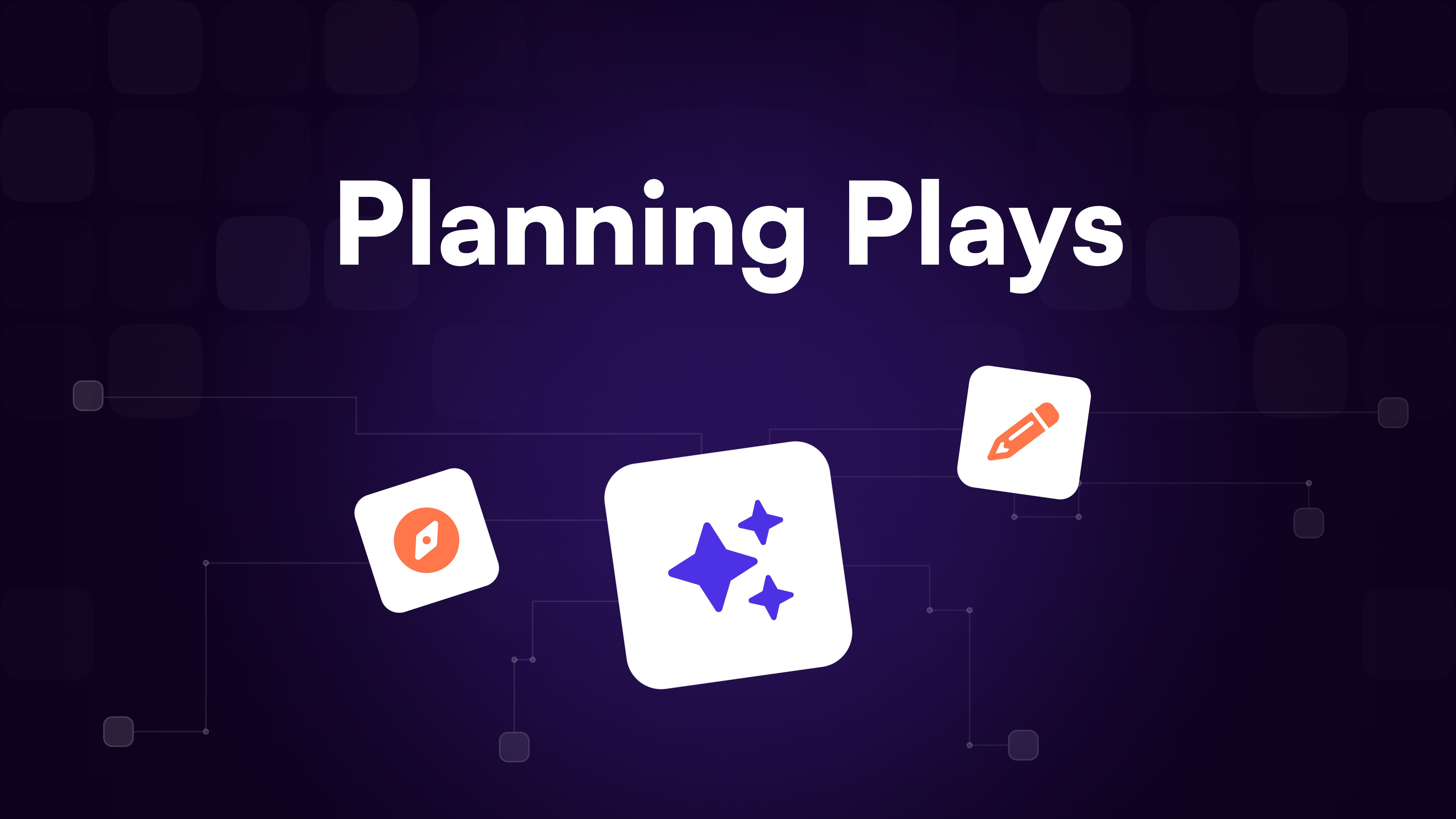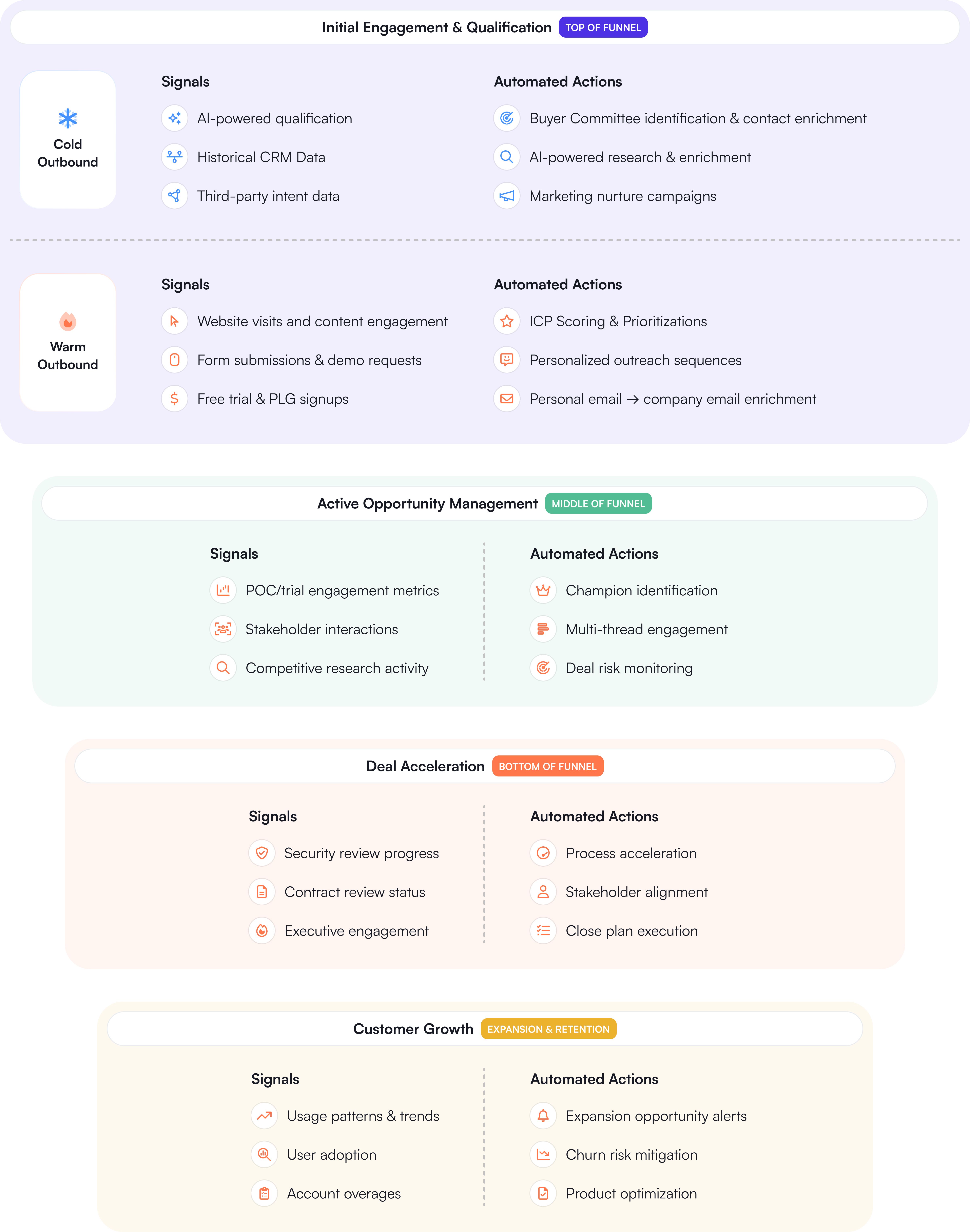Planning Plays

Strategic Framework for Different Funnel Stages
Effective Plays are designed with specific objectives and funnel stages in mind. This guide helps you approach play creation strategically, considering the different requirements at each stage of your sales funnel.

Before diving into specific Play configurations, it's important to understand the strategic differences in plays across the funnel. Each stage requires a different approach to the WHO, WHEN, and WHAT components.
Key Differences Across Funnel Stages
| Funnel Stage | WHO Targeting | WHEN Trigger | Qualification | Enrichment Priority |
|---|---|---|---|---|
| Cold Outbound | Aspirational accounts with no engagement | AI research findings & strategic timing | Critical - primary source of "signals" | High - need full context |
| Warm Outbound | A-fit accounts with engagement | Intent signals (web, product, social) | Valuable for segmentation | High - personalize based on intent |
| Active Deals | Current opportunities | Positive/negative progress signals | Minimal - already qualified | Low - already researched |
| Post-Sales | Current customers | Usage patterns & renewal timing | Selective for large books | Targeted for specific expansion |
The Play Planning Process
Following this systematic process will help you create effective plays for each funnel stage:
- Define your business objective
- Pipeline generation (Cold Outbound)
- Engagement acceleration (Warm Outbound)
- Deal progression (Active Deals)
- Expansion or retention (Post-Sales)
- Determine your target audience
- Identify the specific segment of accounts/contacts
- Consider the strategic value and prioritization
- Define clear criteria for inclusion
- Select appropriate triggers
- For Cold Outbound: AI research findings, strategic timing
- For Warm Outbound: Specific intent signals
- For Active Deals: Positive progress or risk indicators
- For Post-Sales: Usage patterns, renewal timing
- Configure qualification approach
- Design research questions that align with your objectives
- Set the appropriate qualification threshold
- Determine disqualification criteria
- Establish routing logic
- Map to existing team structure and territories
- Define escalation paths
- Set up fallback strategies
- Set up enrichment
- Select account and contact enrichment types
- Configure AI research questions
- Determine required contact information
Cold Outbound Plays: Mental Model
Cold outbound plays target aspirational accounts with no prior engagement. The key shift in mindset is that AI research becomes your primary "signal generator" rather than relying on reactive intent signals.
Strategic considerations:
- Focus on high-value target accounts where personalization is justified
- Invest in thoughtful AI research questions that identify genuine pain points
- Design research to inform both qualification and messaging approach
- Consider strategic timing rather than real-time engagement triggers
Warm Outbound Plays: Mental Model
Warm outbound plays capitalize on real-time intent signals from accounts already showing interest. The key mindset is matching the right response to the specific intent signal type.
Strategic considerations:
- Segment based on signal type and depth of engagement
- Differentiate between anonymous and known visitor engagement
- Consider the content context (technical docs vs. pricing page)
- Align messaging directly with the observed signals
Active Deal Plays: Mental Model
Active deal plays focus on accounts already in your sales process. The key mindset is identifying both positive signals to accelerate and negative signals to mitigate risks.
Strategic considerations:
- Monitor for both positive engagement and concerning gaps
- Focus on multi-threading opportunities
- Watch for competitive signals
- Align with sales process stages
Post-Sales Plays: Mental Model
Post-sales plays target existing customers for expansion or retention. The key mindset is proactive engagement based on usage patterns and upcoming renewals.
Strategic considerations:
- Segment customer base by tier, potential, and risk
- Monitor usage patterns for both expansion and churn indicators
- Time outreach strategically before renewal discussions
- Leverage product usage data to identify expansion opportunities
Iterative Approach to Play Development
Most successful plays don't emerge fully formed. Instead, they develop through an iterative process that starts with broader strategies and gradually refines toward more tactical implementations. This evolution is critical for optimizing both efficiency and effectiveness.
- Focus on funnel optimization
- Identify where your current process has gaps or opportunities
- Consider which stage would benefit most from automation and AI assistance
- Look for areas where your team is already seeing some success that could be scaled
- Define a specific audience
- Segment prospects based on specific, measurable characteristics that correlate with buying potential
- For top-of-funnel plays, distinguish between owned vs. unowned accounts, or accounts with known visitors vs. anonymous visitors
- For PLG motions, segment by product adoption stage (no plan vs. free plan vs. pay-as-you-go)
- For active deals, separate by deal stage (early discussions vs. technical validation vs. late stage)
- For post-sales, segment by current plan tier (self-serve vs. starter vs. enterprise) or renewal timing (accounts renewing in the upcoming quarter)
- Use both firmographic and CRM data to create multi-dimensional cohorts
- Segment prospects based on specific, measurable characteristics that correlate with buying potential
- Identify actionable triggers
- Map the signals or conditions that indicate readiness for engagement
- Prioritize high-value signals to ensure timely outreach
- Set specific threshold criteria that balance lead volume with quality
- Develop initial messaging approach
- Start with your team's existing high-performing sequences as a baseline
- Consider the context of their engagement and pain points
- Craft messages that offer genuine value based on the prospect's specific situation
- Test, learn, and refine with structured cadence
- Implement a review cadence appropriate to your sales cycle:
- For cold outbound: Quarterly or semi-annual reviews work well for most teams, with monthly adjustments if warm signal volume is low
- For warm outbound: Monthly or quarterly reviews to capitalize on emerging trends or new initiatives
- For active deals and post-sales: Align with quarterly business reviews
- Document specific patterns from top performers, who often create micro-personalization tactics without formal processes
- Schedule regular debriefs between RevOps/Sales leadership and frontline reps:
- Quarterly for standard plays
- Monthly for new or high-priority initiatives
- Use structured templates to collect feedback on lead quality, messaging effectiveness, and qualification accuracy
- Analyze key metrics for each play type:
- For cold outbound: Research agent hit rates and relevancy, outreach response rates, and meeting conversions
- For warm outbound: Signal-to-meeting conversion ratios, response metrics for various buyer personas, down funnel revenue impact (influenced deals, revenue)
- For active deals: Deal velocity, multi-threading statistics, close rate by signal type, down funnel revenue impact (influenced deals, revenue)
- For post-sales: Expansion rate, impact on net retention
- Document learnings in a centralized playbook that evolves with each iteration cycle
- Implement a review cadence appropriate to your sales cycle:
- Scale successful patterns
- Once you've identified what works, create more specialized variations
- Apply successful approaches to additional segments
- Integrate Plays into onboarding and enablement resources
Evolution Patterns Across Play Types
Different play types evolve in distinct ways through the iteration process:
Cold Outbound Evolution:Initially, teams select a handful of broad research questions connected to potential pain points. Over time, they refine these to more granular queries. For example, a general question like "Do they have AI initiatives?" might evolve to "Is the prospect currently hiring for roles related to conversational AI, speech recognition, or voice user experience design?" This increased granularity allows for more specific pain identification and value proposition positioning.
Warm Outbound Evolution:Teams typically start by tracking basic intent signals, then progress to mapping specific signal types to tailored messaging. For instance, they might develop different approaches for prospects viewing technical documentation versus pricing pages versus specific blog post clusters. This mapping becomes increasingly sophisticated as patterns emerge.
Active Deal Evolution:As teams collect more data on deal progression, they identify predictive patterns. They might discover that in late-stage deals, prospects typically engage with specific legal/compliance documentation, or that certain product activity volumes during POCs strongly correlate with successful closings. Koala's content reports help identify which product events and/or marketing page visits correlate most strongly with down-funnel movement.
Post-Sales Evolution:Expansion and retention plays often start with broad signals like general product adoption, then evolve to track more nuanced indicators. Teams discover that specific feature usage patterns or combinations of AI agent research signals (ie - geographic expansion, product launches, hiring trends, etc.) provide earlier or more reliable indicators of expansion readiness or churn risk.
Remember that play development is a collaborative process between sales leadership, RevOps, and frontline reps. The most effective plays emerge from this partnership, combining strategic direction with practical feedback from the field.
In the following sections, we'll explore specific play types for each funnel stage, starting with Warm Outbound Plays.
Explore other lessons
Koala 101
Learn strategies on how to best leverage the platform from research to value-add messaging
5 videos
Lists & Filtering
Learn how you can manage the different views within Koala to fit perfectly for your workflow
5 videos
Prospecting
Understand how you can use Koala's waterfall prospecting functionality to quickly identify the buyer committees for your accounts.
2 videos
Account Research
See how you can best leverage Koala for in-depth insights on your top accounts and prospects
3 videos
Scoring & Signals
Discover how you can cut through the noise with fit scoring and intent signals to find hot opportunities
2 videos
Get started in minutes
You're one pixel install away from discovering the prospects already on your site. Start with our generous free plan today.